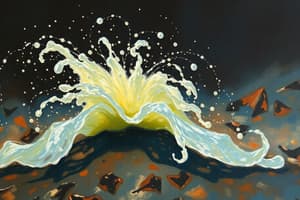Podcast
Questions and Answers
A box rests on an inclined plane. At what angle will the component of gravitational force parallel to the plane overcome static friction, causing the box to slide?
A box rests on an inclined plane. At what angle will the component of gravitational force parallel to the plane overcome static friction, causing the box to slide?
- When the coefficient of static friction is zero.
- When the parallel component of gravity exceeds the maximum static friction force. (correct)
- When the normal force is maximized.
- When the inclined plane is perfectly level, negating any gravitational influence.
An object is initially at rest. Which of the following scenarios would result in the object experiencing a net force greater than zero?
An object is initially at rest. Which of the following scenarios would result in the object experiencing a net force greater than zero?
- An object at rest will always have no net force acting upon it.
- Balanced gravitational and normal forces.
- A single applied force without any opposing forces. (correct)
- Equal and opposite forces of static friction and an applied force.
Two objects with different masses are dropped simultaneously from the same height in a vacuum. How does gravity affect their acceleration?
Two objects with different masses are dropped simultaneously from the same height in a vacuum. How does gravity affect their acceleration?
- The heavier object experiences greater gravitational acceleration.
- Both objects experience the same gravitational acceleration. (correct)
- The lighter object experiences greater gravitational acceleration.
- The object with greater surface drag will accelerate more slowly.
A student pushes a book across a table. What happens to the force of sliding friction if the student applies a downward force in addition to the horizontal force?
A student pushes a book across a table. What happens to the force of sliding friction if the student applies a downward force in addition to the horizontal force?
Considering the relationship between mass, distance, and gravitational force, what change would result in the greatest decrease in gravitational force between two objects?
Considering the relationship between mass, distance, and gravitational force, what change would result in the greatest decrease in gravitational force between two objects?
An astronaut has a mass of 70 kg. What changes when the astronaut is on the moon compared to when they are on Earth?
An astronaut has a mass of 70 kg. What changes when the astronaut is on the moon compared to when they are on Earth?
A car is traveling at a constant velocity. Suddenly, the driver applies the brakes. How does friction influence the car's motion?
A car is traveling at a constant velocity. Suddenly, the driver applies the brakes. How does friction influence the car's motion?
What distinguishes a contact force from a non-contact force?
What distinguishes a contact force from a non-contact force?
Flashcards
Force
Force
A push or pull on an object, measured in newtons (N).
Contact Force
Contact Force
A force that requires direct contact between objects.
Non-Contact Force
Non-Contact Force
A force that acts between objects without direct contact.
Friction
Friction
Signup and view all the flashcards
Static Friction
Static Friction
Signup and view all the flashcards
Sliding Friction
Sliding Friction
Signup and view all the flashcards
Gravity
Gravity
Signup and view all the flashcards
Weight
Weight
Signup and view all the flashcards
Study Notes
- Forces are explored
- Chapters include gravity, friction, electric forces, and magnetic forces
- Also looks at electric, magnetic, and gravitational forces using Stemscopes
The Big Idea
- How forces change the motion of an object
Lesson 1: Gravity and Friction
- Key questions involve contact and non-contact forces
- What is universal gravitation?
- How friction affects motion between sliding objects
Types of Forces
- A force a push or a pull measured in newtons (N)
- Two types of forces are contact and non-contact
Contact Force
- A push or pull on one object by another through touching
- Pushing a container, pressing computer keys, and friction are examples
Non-Contact Force
- A push or pull on one object by another without touching
- Gravity, magnetic, and electrical forces are examples
3 Types of Friction
- Friction resists motion between touching objects
Static Friction
- This prevents objects from sliding past each other
Sliding Friction
- Sliding friction opposes the motion of objects sliding past each other
Fluid Friction
- Friction occurs between a surface and a fluid, like water
Static Friction vs Sliding Friction
- Static friction force of -100N with an applied force of 100N nets 0N
- Sliding friction of -70N with an applied force of 200N
Gravity
- An attractive force between all objects with mass
- Mass an object's amount of matter
Weight vs Mass
- Weight the amount of gravitational force, measured in newtons (N)
- An astronaut weighs 539N and has a mass of 55kg on Earth; their weight and force would change on the moon (F=ma)
Electrical Force
- Static charge unbalanced positive or negative charge on an object
- Opposite charges attract and same charges repel
Variables Affecting Electric Charge
- Amount of charge affects the electric force
- There is less electric charge with more distance
Magnetic Force
- Magnet an object attracting metal iron
- Magnetic pole the place on a magnet with strongest force concentration
- Opposite poles attract and same poles repel
Variables Affecting Magnetic Strength
- Magnet size matters
- Distance between magnets affects the magnetic force
Studying That Suits You
Use AI to generate personalized quizzes and flashcards to suit your learning preferences.




